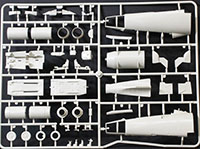
Kitty Hawk Models 1/48 F-101B Voodoo Kit First Look
By Michael Benolkin
| Date of Review | June 2018 | Manufacturer | Kitty Hawk Models |
|---|---|---|---|
| Subject | F-101B Voodoo | Scale | 1/48 |
| Kit Number | 80114 | Primary Media | Styrene, Photo-Etch |
| Pros | First injection-molded kit of this subject | Cons | See text |
| Skill Level | Experienced | MSRP (USD) | $54.95 |
First Look
 |
 |
 |
 |
 |
 |
The McDonnell Voodoo was initially designed as a long-range bomber escort shortly after World War II based upon the experience of the P-51 support of the Eighth Air Force bombing missions. The early prototypes were designated as XF-88 and powered by two XJ-34 turbojets. Designed before Chuck Yeager's flight through the sound barrier, the XF-88 was subsequently upgraded with early afterburners. While the XF-88 won the flight evaluations for the program, changing requirements led to the program's cancellation in 1950.
Renewed interest in the concept came a year later and the F-88 was redesigned to accept two J57 engines (the same engine as the F-100 Super Sabre and F-8 Crusader) and redesignated as F-101 Voodoo. Leadership of the program shifted from SAC to TAC and the F-101A entered service in 1957 though it was still experiencing some teething problems. The F-101C soon followed with increased structural strength to meet its original 7.33G maneuver requirement as well as accommodate additional internal fuel.
During the early 1950s, the Air Force had launched a program called 1954 Interceptor, which encompassed advances in avionics, weapons, and engine technology. The selected airframe was Convair's F-102 Delta Dagger, and while it was on schedule, the avionics and weapons were not. Looking for an interim supersonic interceptor, McDonnell proposed the F-109 which was a two-seat all-weather interceptor variant of their F-101A. The Air Force adopted the idea, but designated the new aircraft as the F-101B. This new interceptor replaced its four cannons with four AIM-4 Falcon missiles, and many were later upgraded to carry the AIR-2 Genie nuclear rocket. Ironically, this 'interim' interceptor remained on active duty and in air national guard service well after the F-102 was retired.
Four years after the release of the single-seat F-101A/C Voodoo kit, Kitty Hawk has released the two-seat interceptor. While Monogram has dominated the market for this subject in 1/48 scale for decades, this kit provides a new-tool alternative. Where the first kit was developed in collaboration with Detail and Scale, you can see from the low-tech paper and tape editing of the kit box that the collaboration has evidently ended.
Molded in light gray styrene, this kit is presented on six parts trees plus two trees of clear parts and one fret of photo-etched parts. As with the previous release, this kit features finely scribed surface detailing. Let's take a closer look.
Among the features and options in this kit:
- Nicely detailed ejection seats with photo-etched crew restraints
- Detailed cockpit with choice of decal or photo-etched instrument panel and side console details
- Detailed avionics bays in left and right side nose compartments
- Positionable bay doors
- Radar dish under radome
- Nicely detailed intake ducts with J57 compressor faces
- Detailed afterburner chambers
- Positionable speed brakes
- Positionable landing flaps
- Positionable ailerons
- Positionable stabilator
- Positionable rudder
- Positionable landing gear
- Missile launch pallet rotates to reveal two more missiles
- Optional RF-101B nose camera fairing included
External stores include:
- 2 x external fuel tanks
- 2 x AIM-4A Falcon
- 2 x AIM-4B Falcon
- 2 x AIR-2 Genie
Markings are provided for five subjects:
- CF-101, 17395 (59-0395), 409 Sqn, RCAF
- F-101B, 57-0364, 60 FIS, 1970
- F-101B, 59-0417, 136 FIS, 1968
- F-101B, 57-0370, 437 FIS, 2967
- RF-101B, 59-0434
Note: The color profiles in the instructions might be a bit confusing. They may have been done in haste, but the tail numbers in each title don't always match up with the tail numbers in the four-view diagrams. The color profile for the RF-101B is especially interesting as they show this aircraft also armed with AIM-4 Falcons. I'm sure there were more than a few recce pilots that wished they had missiles on the aircraft!
The kit does have more than a few parts to build up the fuselage, but the positionable avionics bay doors will make this kit stand out on the contest table. There are a number of colorful F-101B color schemes out there and no-doubt we'll see some of these available in the aftermarket should the subjects included in this kit not be sufficient. Kitty Hawk has also announced the RF-101C/G/H kit will be coming sometime in our future for those who are interested in the 'unarmed and unafraid' recce birds.
My sincere thanks to Kitty Hawk Models for this review sample!







